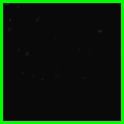Resolution rules:
Images should be 300 dpi (dots per inch) at the final size in the layout.
Images which include text should be 400 dpi at the final size in the layout.
Resolution and image size are inversely proportional to each other. Enlarge an image, the resolution decreases; reduce an image, the resolution increases. Example: a 2 x 2" image at 300 dpi (acceptable) enlarged to 4 x 4" has a new resolution of 150 dpi (unacceptable).
Low resolution images print fuzzy, jagged and blurry.
The settings used during the original "capture" of an image (ie: scanning, digital camera, etc) determine its base resolution. Resolution can only be improved by decreasing the image size, or by recapturing the image at a higher quality setting.
Recommended minimum resolution for printing is 300 dpi; computer monitors generally have a display setting of 72 dpi. If we indicate that some of your images have low resolution, they may not look bad on your monitor but will likely print blurry or jagged.
Things to avoid:
Web images are predominately low resolution (72-96 dpi) GIF or JPEG files. This resolution is good for quick transmission over the internet, but is not acceptable for use in printing. Do not save images or graphics from a website to use in your print project!
Upsampling is when a low resolution image is saved to a higher resolution with no changes in dimensions. Upsampling adds more pixels/dots per inch (dpi), but creates blurry images, ugly blocks of color, and high contrast in images. The only way resolution can be improved is by decreasing the image size, or by recapturing the image at a higher quality setting.








